Table of contents
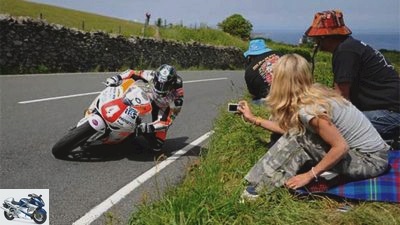
Davison
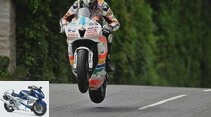
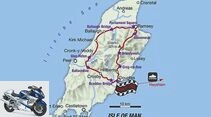
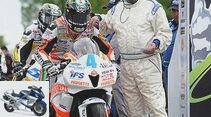
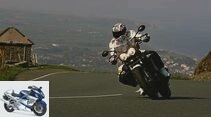
37 pictures
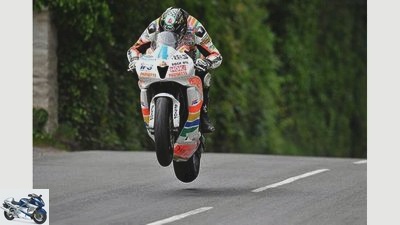
Motocom
1/37
The Isle of Man Tourist Trophy – the world’s most dangerous motorcycle race.

archive
2/37
The Mountain Course is 60.66 kilometers long.
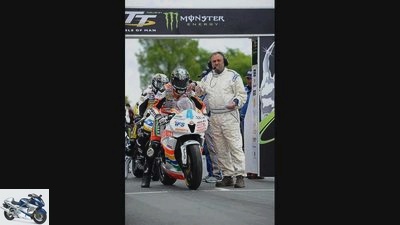
Motocom
3/37
The Isle of Man Tourist Trophy – the world’s most dangerous motorcycle race.
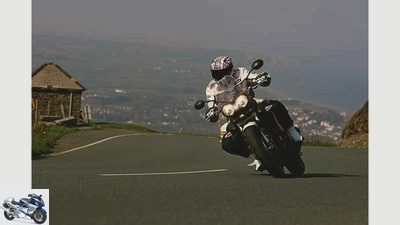
Motocom
4/37
The Isle of Man Tourist Trophy – the world’s most dangerous motorcycle race.
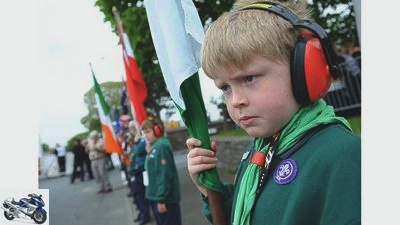
Motocom
5/37
The Isle of Man Tourist Trophy – the world’s most dangerous motorcycle race.
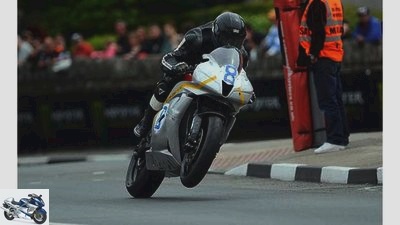
Motocom
6/37
Guy Martin in a wheelie across the St. Ninian junction.
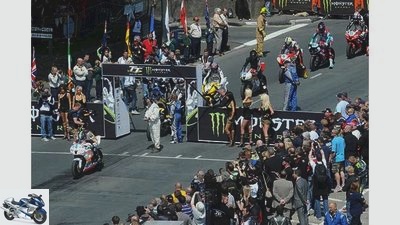
Motocom
7/37
The Isle of Man Tourist Trophy – the world’s most dangerous motorcycle race.
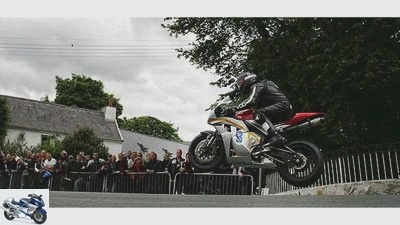
Motocom
8/37
Hanging in the air: Guy Martin at the Tourist Trophy super sports race.

Motocom
9/37
The Isle of Man Tourist Trophy – the world’s most dangerous motorcycle race.
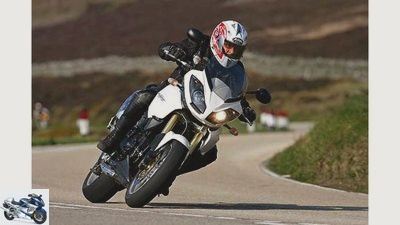
Motocom
10/37
The Isle of Man Tourist Trophy – the world’s most dangerous motorcycle race.
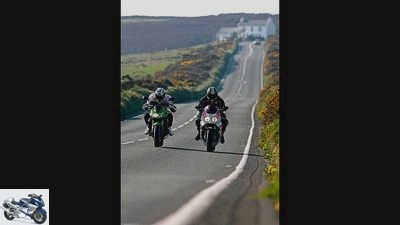
Motocom
11/37
On a quick tour with Johnny Barton.
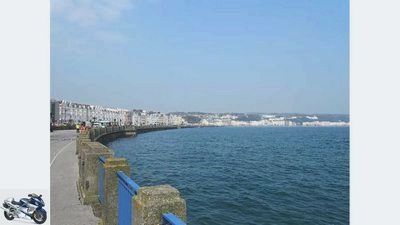
Seitz
12/37
The Isle of Man Tourist Trophy – the world’s most dangerous motorcycle race.
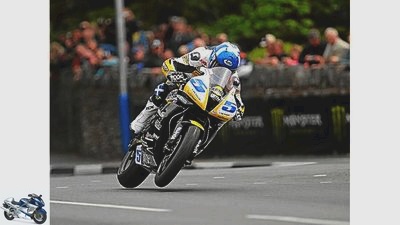
Motocom
13/37
The Isle of Man Tourist Trophy – the world’s most dangerous motorcycle race.
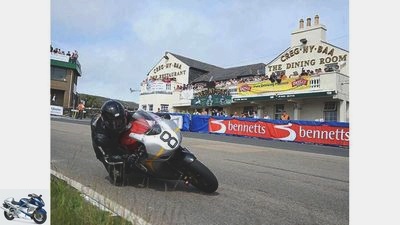
Motocom
14/37
The Isle of Man Tourist Trophy – the world’s most dangerous motorcycle race.
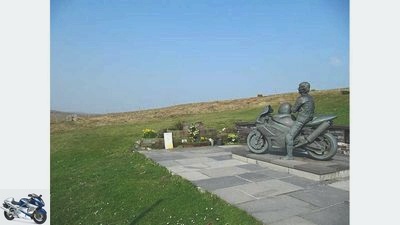
Seitz
15/37
The legendary Joey Dunlop watches over the route in bronze. He won the race 26 times.
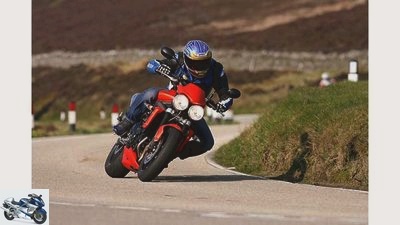
Motocom
16/37
The Isle of Man Tourist Trophy – the world’s most dangerous motorcycle race.
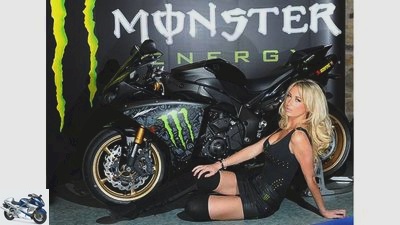
Davison
17/37
The Isle of Man Tourist Trophy – the world’s most dangerous motorcycle race.
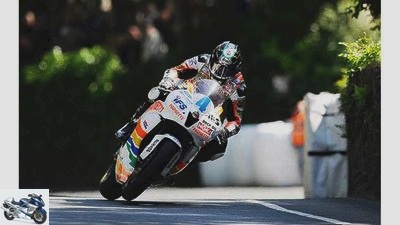
Motocom
18/37
The Isle of Man Tourist Trophy – the world’s most dangerous motorcycle race.
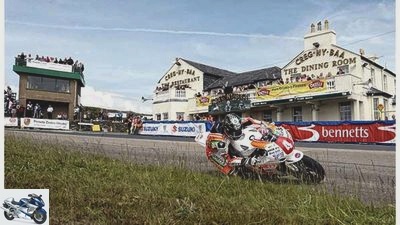
Motocom
19/37
The Isle of Man Tourist Trophy – the world’s most dangerous motorcycle race.
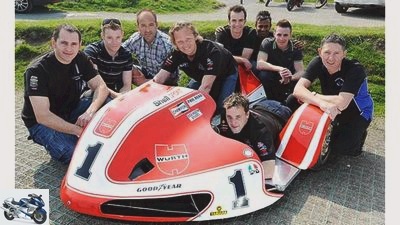
Davison
20/37
The kings of the sidecar: Simon Neary, Ben Birchall, Tim Reeves, Klaus Klaffenbock, Dan Sayle, Paul Knapton, Dipash Chauhan, Tom Birchall and John Holden at the Isle of Man TT.
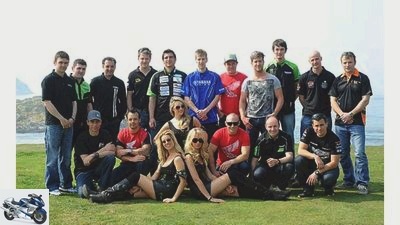
Davison
21/37
Group picture with participants of the Tourist Trophy 2011.
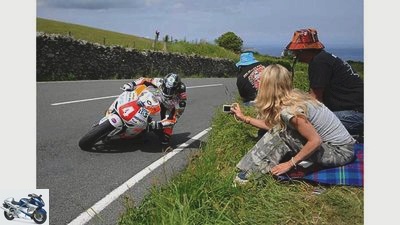
Motocom
22/37
The Isle of Man Tourist Trophy – the world’s most dangerous motorcycle race.
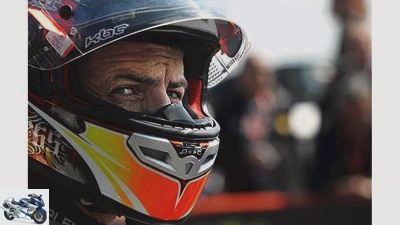
Motocom
23/37
Relentless Suzuki rider Cameron Donald at the 2011 Tourist Trophy.
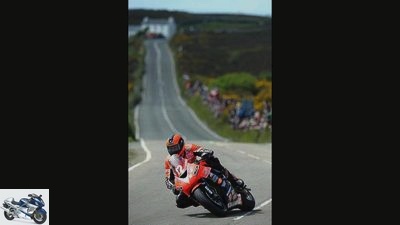
Motocom
24/37
The Isle of Man Tourist Trophy – the world’s most dangerous motorcycle race.
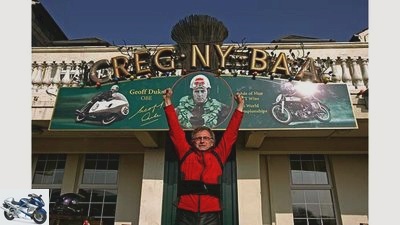
Motocom
25/37
The Creg Ny Baa is the most popular meeting point along the Tourist Trophy circuit.

Motocom
26/37
Team Padgett’s Honda at the 2010 Tourist Trophy.
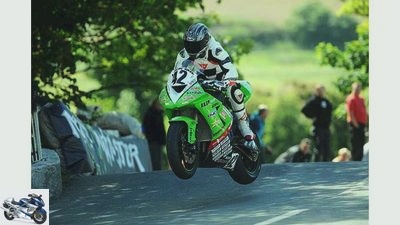
Motocom
27/37
Michael Dokoupil jumps far on Ballaugh Bridge on his motorcycle.
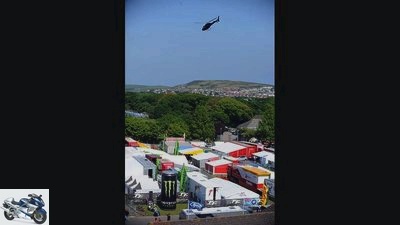
Motocom
28/37
Tourist Trophy 2011: With the helicopter over the paddock.
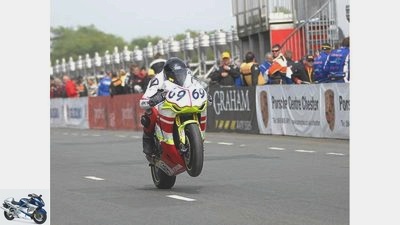
London
29/37
The Isle of Man Tourist Trophy – the world’s most dangerous motorcycle race.
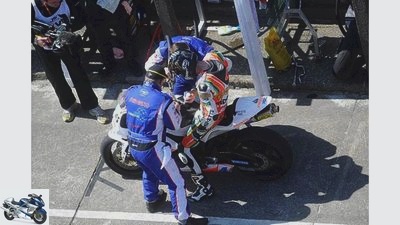
Motocom
30/37
Half time in the senior race of the Tourist Trophy 2011 – refueling and changing tires.
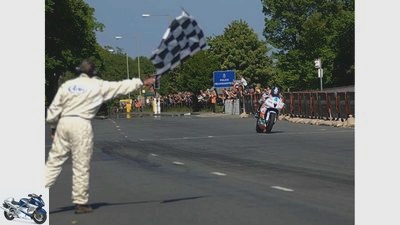
Motocom
31/37
Ian Hutchison on his way to a second victory in the Supersport race at the 2010 Tourist Trophy.
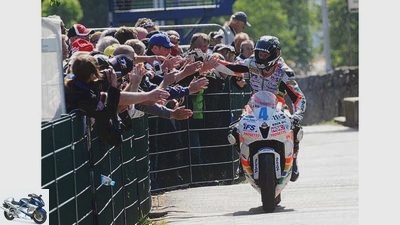
Motocom
32/37
Ian Hutchison celebrates his fourth race win at the 2010 Tourist Trophy.

Davison
33/37
The Tourist Trophy is all about these beautiful trophies.

Motocom
34/37
Superstock Tourist Trophy 2010: Ian Hutchison after his second race win.
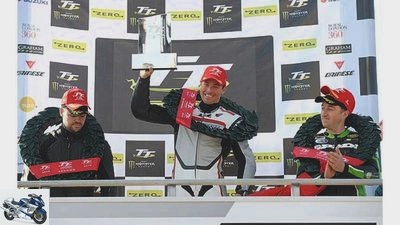
Motocom
35/37
Zero TT 2010: Mark Miller celebrates his victory in front of Rob Barber and James McBride on the Isle of Man. In 2011 it was only enough for Miller to finish second.
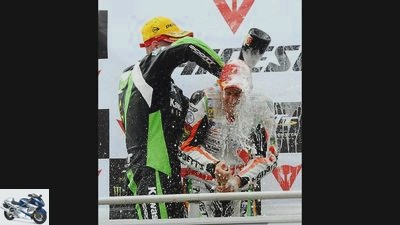
Motocom
36/37
Champagne shower for Ian Hutchinson after winning the Supersport Tourist Trophy.
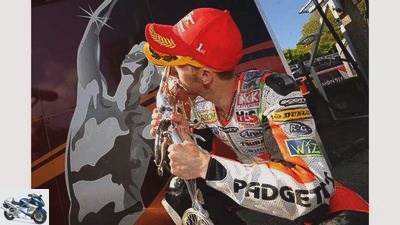
Motocom
37/37
With passion: Ian Hutchison with his trophy from the Tourist Trophy 2010.
Sports & scene
Motorsport
Tourist Trophy: Road racing on the Isle of Man
Report: Tourist Trophy
Tourist Trophy: Road racing on the Isle of Man
Content of
It is considered the most dangerous motorcycle race in the world. At the same time, the TT is the most famous. Once you’ve been there, you can’t escape it. The drivers are addicted.
Uwe Seitz
05/24/2011
Comparing the Tourist Trophy to other motorcycle races is hopeless. “Unique in the world”, it comes from Keith Amor like a shot from a pistol. The Scot should know. Since his debut in 2007 he has been on the podium four times and has ridden in the British Superbike as well as in the World Endurance Championship. Even other road racing highlights such as the North-West 200 in Ireland or the Ulster Grand Prix in Northern Ireland cannot be compared with the TT for Amor. Here on the Isle of Man, different laws apply, different skills count, different types and motorbikes are required. And the TT is timeless. While the race tracks are interchangeable in the GP or the Superbike World Championship, the 60.66 kilometer long, legendary Mountain Course has been used on the small island in the Irish Sea for 100 years.
At ever higher speeds. The bar for the average speed for one lap is currently an unbelievable 211.75 km / h. To illustrate: Phillip Island is currently the fastest GP track, Casey Stoner achieved a lap average of 177.7 km / h there in 2010 in his pole position. On an optimal surface and with endless run-off zones. It’s different with the TT. Embankments, walls, telephone poles, mailboxes and the odd pub are elementary for TT drivers “Marginal phenomena” the racetrack. Just like manhole covers, heavy bumps, road markings, a number of potholes and desolate asphalt patchwork provide the subsurface for these crazy laps. Not least because of this, this road race enjoys the dubious reputation of many – whether motorcycle fans or not “pure suicide”.
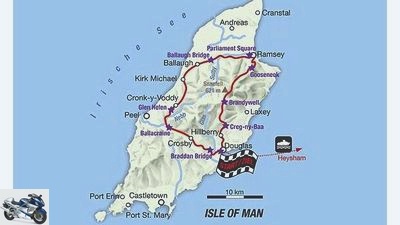
archive
The 60.66 kilometer route runs from Douglas to Douglas.
In fact, over 200 people have died in the TT since the first race on the current circuit. This reputation became more and more threatening for the TT. On the one hand, the interest of top international drivers has declined sharply for more than 20 years – when the race lost its Grand Prix status in 1976, top GP drivers stayed away from the TT. On the other hand, the event froze in its tradition for a long time, lived on its own heroes, such as the undisputed TT king Joey Dunlop with 26 victories, and increasingly turned into a purely British spectacle, which at most freaks and bloody amateurs from around the world attracted as a racing driver. “Above all, the many inexperienced pilots gave the TT this terrible reputation”, says Johnny Barton, who is driving his 20th TT this year. Over 15 years ago, Barton moved to the island from Kent for the event. He is now part of the motorsport development committee headed by mastermind Paul Phillips, which has been in operation for five years. Its troop is now in strict control and has given the TT a completely new, professional structure behind the scenes. Today it’s impossible to just show up on the island and register for the race. Without a precise racer vita nothing works, without references it will be difficult and if Johnny has the impression that you can’t do it, then that’s all over the place. Barton, himself already runner-up in the TT, will take part together with TT winner Richard “Milky” Quayle the applicants under their wing. They drive them over the route several times, explain the special features and test their driving skills: “If you drive fast on a normal racetrack, you are not automatically a fast road racer”, knows Barton. “You have to have brains, be able to draw a line between willingness to take risks and cool calculation.” And it takes time to become a shrewd TT driver. “Three years until you have sufficient knowledge of the route”, says Quayle, who introduced the German Rico Penzkofer to the Isle of Man. “Rico is the parade type of driver we’re looking for here”, tells Milky. “In addition to his driving skills, he has the feeling that you need here.” It is a great thing for Milky that Penzkofer is already considered a top 5 driver by the experts after finishing twelfth last year: “We want to make the TT big again internationally and establish it as a respected motorcycle race worldwide. For this we need international drivers from Europe, USA, Australia, everywhere who are competitive.”
But the ambitions of the TT makers are now continuing. They have already sent out scouts looking for other road races to co-host a real road world championship with the TT. Macau in China would be such a race, possibly also Horice in the Czech Republic. But then it will get thin, because in our world, which is strictly regulated in all areas of life, in which everyone is made liable for everything and horrific insurance must be taken out for events – quite apart from the fact that politically responsible people usually fear the scolding of individuals more than the enthusiasm of the sports fans – the chances are pretty slim of launching a race like the TT again somewhere.
“Somehow that’s part of the fascination”, Local hero Conor Cummins consoles himself. “I’ve been driving these roads since I was a child. If you race along that exact route, there’s something excitingly bad about it. I hurtle through my hometown Ramsey at over 200 km / h, and I feel like the greatest lawbreaker.”
Nobody denies that road racing à la TT is particularly dangerous. Especially not the drivers. “It’s scary and wonderful at the same time, the tension during the race week is almost unbearable”, says Keith Amor. “But whoever comes here knows how dangerous it is. Nobody forces us. But I consider it my right.” Michael Dunlop, 2009 TT winner and nephew of Joey Dunlop, lost his uncle in a road race in Estonia in 2000. His father Robert died at the North-West 200 in 2008. Two days later Michael won the 250cc class there. The 23-year-old leaves no doubt about his determination: “The TT is my life. If I breathe it out here, that’s it – that’s that.” The TT drivers talk openly about the risk, do not avoid the topic. “To be able to drive in the TT, you have to accept that you will come here at the end of May and that it may have been. If you can’t sit down and discuss this openly with someone, you shouldn’t be driving here”, David Jeffries once said in an interview. The nine-time TT winner had a fatal accident on May 29, 2003 near Crosby in a TT training session.
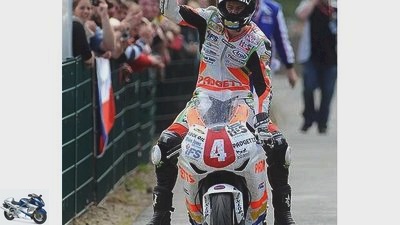
Motocom
Ian Hutchinson wins the 2011 Tourist Trophy Superstock race.
“That is one of the most terrible things about the TT”, Johnny Barton shakes his head. “But if you ask me what’s really the worst about TT, my honest answer would be: It’s only once a year.” John McGuinness has shared Barton’s opinion since last year at least: “I’ve always won at least one race in seven years. And not a single one last year. Terrible, a whole year is in vain!” After McGuinness had simply not reached his normal level in the junior race, technology thwarted his plans in the TT premier class, the senior race. “durability”, McGuinness smiled bitterly, that’s why it makes a good TT bike. The art of building a TT motorcycle, however, means willingness to compromise in all areas. “In the mountains, you could certainly use the top-end power of a pure superbike. But there are so many full throttle sections on the whole lap that the engine has to be able to cope with that”, explains Johnny Barton. The most important thing about the TT-Racer is driving stability. Anyone who arrows with almost 300 things over undulating ground between garden walls, appreciates nothing as much as a stable, smoothly straight motorcycle. The setup is a huge challenge. “My TT bike is also significantly more comfortable than my racetrack motorcycles”, says TT winner Cameron Donald. With almost all top riders, the footrests are a little further down, the stubs higher up and the racing windshield offers significantly more wind protection. “In the senior race we drive the full lap six times. You try to relax wherever you can. With the many hits, jumps and wheelies that there are here, the motorcycle has to be as tender as possible to you”, Keith Amor strokes his Fireblade.
All well-known riders agree that the TT is physically tough for the rider as it is for the bike. But the mental strain is not as high in any other race as on the Isle of Man. “At the Ulster-GP or the North-West 200 there is the normal start, you fight hand-to-hand. Here you are alone with the watch – that is something completely different”, Donald becomes more precise. “It’s a fight against the course, against the clock, against your fears”, McGuinness puts it in a nutshell. “Even weeks after the TT, I’m a wreck”, describes Cupid the burden. “You are downright brain dead afterwards. During the TT, I constantly drive mentally over the track, memorize braking and turning points again, here quickly down two gears, because immediately accelerate up and up, not too close to the wall, watch out for the curb, the curve closes. This is how it works for two weeks, including a training week.” Memorizing a distance of more than 60 kilometers on public roads is a bit different for every driver. Some, like Johnny Barton or Cameron Donald, all have distinctive points with names in their heads. In between, they tell of telephone booths in the corner of their eyes as a reference point, manhole covers as a braking point or a chimney that appears directly in front of the blind left. Others obviously have no plan where exactly they are going, but mentally only divide the course into gear steps and throttle position. One of them is Ian Hutchinson, who in 2011 became the first person to win all five important solo races of the TT: “I’ve heard of Brandywell or Kate’s Cottage, but I couldn’t tell you where they are. Ask me about third-course passages, no problem, but if I had to follow signs I would get lost.” As the individual driver does, knowing the route inside out is a basic requirement. “You absolutely have to give yourself the time. But if your life depends on whether you have the tree on your screen or if you go straight to the iron after the hedge, then your head works completely differently”, sums it up Keith Amor. There is no doubt that the TT is life-threatening, but above all it is unique.
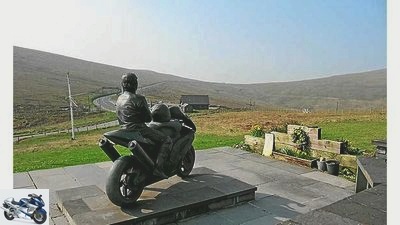
Seitz
The legendary Joey Dunlop watches over the mountain route in bronze.
TT in brief
This year the TT is going for the 100th time over the 60.66 kilometer long mountain course with a total of 240 curves. The most important classes are the Supersport, i.e. the 600cc racer, which used to run as a junior TT, the near-series Superstock with a displacement of one liter and the open-top superbikes. The fastest 80 drivers compete in the grand finale on the Superbikes of the Senior TT. You will drive between four (600) and six laps, then with a fuel and tire change stop halfway through (senior). There is also the sidecar class, which still enjoys cult status. A race for e-bikes has also been started for two years. The TT usually consists of one week of training sessions and one week of races. The streets are closed for this. In between, normal everyday traffic runs along the “race track”. In the event of rain or poor visibility on Snaefell Mountain, it will be postponed accordingly. All drivers start at the “Grand Stand” in Douglas alone, every 10 seconds.
Related articles
-
Isle of Man: Tourist Trophy, people, nature
Breakers, Werel 20th pictures Breakable 1/20 Laxey Wheel aka Lady Isabella: The largest water wheel in the world is in Laxey. Breakable 2/20 Treat…
-
Tourist Trophy Isle of Man 2013
Henniges 34 pictures Henniges 1/34 Everyone on the roadside is excited. Henniges 2/34 The big moment after a journey of several hours: the ferry reaches…
-
Report – Tourist Trophy 2015 on the Isle of Man
Kaschel 30th pictures Borner 1/30 The motorcycles, the drivers, the island, the press: a wild mix at the TT. Michael Dunlop as the title hero on the new…
-
On the go: The Tourist Trophy on the Isle of Man
Lohse 29 pictures Woollett 1/29 1974: Helmut Dahne in action on the BMW r 75 in the production class; he finished second. Woollett 2/29 1967: Mike…
-
Isle of Man Tourist Trophy 2017
Bernd Fischer 70 pictures Bernd Fischer 1/70 John McGuinness, 23-time TT winner, fanatic and one of the favorites, … Bernd Fischer 2/70 … fell badly…
-
Tourist Trophy 2013 – The bike for the Isle of Man by Horst Saiger
Saiger 8th pictures Davison 1/8 Shortly before the TT, the nervousness of PS racer Horst Saiger increases. Saiger 2/8 Saiger is the reigning Swiss…
-
John McGuinness competes with Norton in the 2018 Tourist Trophy
Norton Sports & scene Motorsport John McGuinness competes with Norton in the 2018 Tourist Trophy McGuinness starts at the TT 2018 with Norton Comeback of…
-
Isle of Man Tourist Trophy: Electric racing class is canceled
Toni Borner Sports & scene Motorsport Isle of Man Tourist Trophy: Electric racing class is canceled Isle of Man Tourist Trophy Electric racing class is…
-
to travel Travel report Isle of Man Travel report Isle of Man Isle of Man: The motorcycle island It is impossible to report about the Tourist Trophy…
-
Pacemaker 13th pictures Pacemaker 1/13 It doesn’t get any faster – a lap on the Isle of Man and its 66 kilometer long course. Pacemaker 2/13 TT trainer…